How to count in a For or While Loop in Python
Last updated: Apr 9, 2024
Reading time·5 min

# Table of Contents
- Count in a for loop in Python
- Count in a for loop starting from a different number
- Counting in a for loop manually in Python
- Counting in a for loop using range()
- Counting in a While loop in Python
# Count in a for loop in Python
Use the enumerate() function to count in a for loop.
The function takes an iterable and returns an object containing tuples, where the first element is the index, and the second is the item.
my_list = ['a', 'b', 'c'] # ✅ count in for loop for index, item in enumerate(my_list): print(index, item) # 👇️ # 0 a # 1 b # 2 c
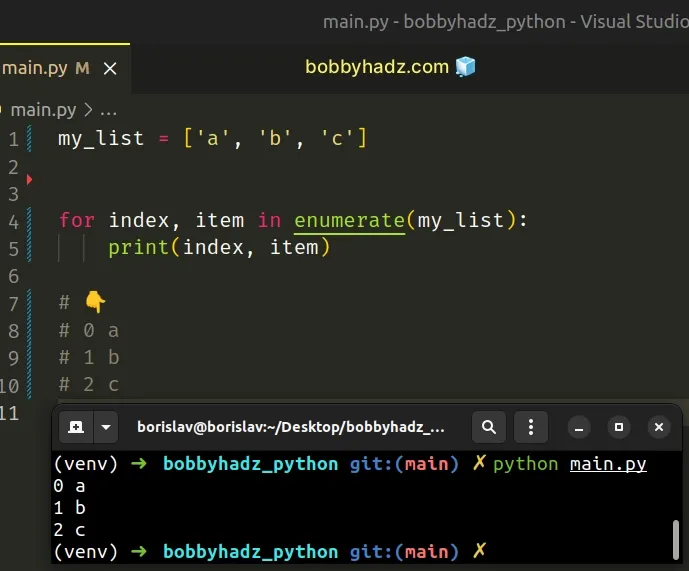
The enumerate() function takes an iterable and returns an enumerate object containing tuples where the first element is the index, and the second is the item.
We can directly unpack the index (or count) and the item in our for loop.
my_list = ['a', 'b', 'c'] for index, item in enumerate(my_list): print(index, item) # 👇️ # 0 a # 1 b # 2 c
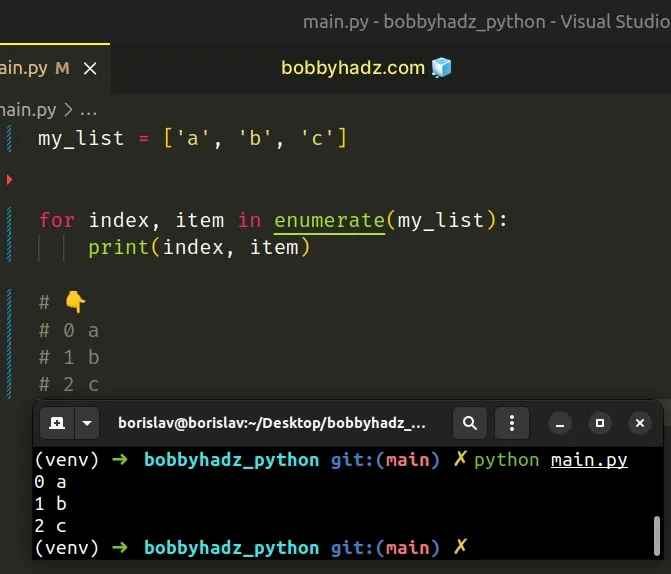
The enumerate function takes an optional start argument, which defaults to
0.
Note: if you need to count in a WHILE loop, click on the following subheading:
# Count in a for loop starting from a different number
If you need to start the count from a different number, e.g. 1, specify the
start argument in the call to enumerate().
my_list = ['a', 'b', 'c'] for count, item in enumerate(my_list, start=1): print(count, item) # 👇️ # 1 a # 2 b # 3 c
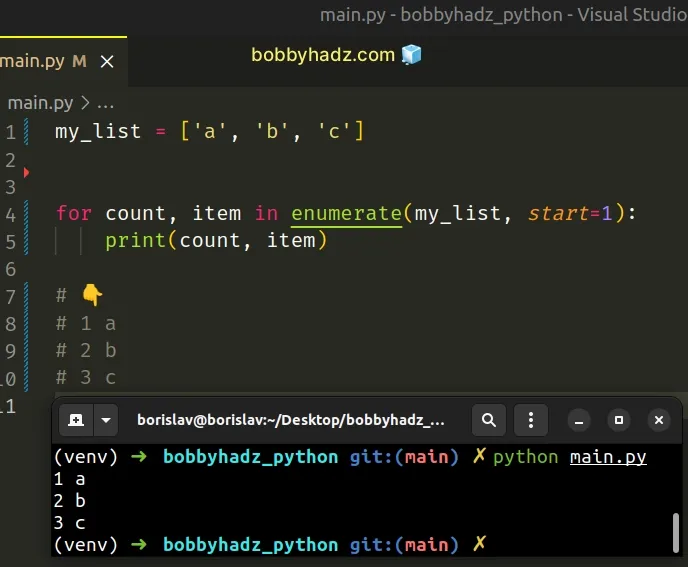
The count variable has an initial value of 1 and then gets incremented by
1 on each iteration.
Alternatively, you can manually count in the for loop.
# Counting in a for loop manually in Python
This is a three-step process:
- Initialize a
countvariable and set it to a number. - Use a
forloop to iterate over a sequence. - On each iteration, reassign the
countvariable to its current value plus N.
my_list = ['a', 'b', 'c'] count = 0 for item in my_list: count += 1 print(count) print(count) # 👉️ 3
We declared a count variable and initially set it to 0.
+= operator to reassign the variable to its current value plus N.The following 2 lines of code achieve the same result:
count += 1count = count + 1
Here is an example that uses the longer reassignment syntax.
my_list = ['a', 'b', 'c'] count = 0 for item in my_list: count = count + 1 print(count) print(count) # 👉️ 3
# Counting in a for loop using range()
You can also use the range() class to count in a for loop.
a_list = ['bobby', 'hadz', 'com'] for index in range(len(a_list)): # 0 bobby # 1 hadz # 2 com print(index, a_list[index])
The range class creates an iterator object of the specified length.
This approach is very similar to using enumerate(), however, the enumerate
function is more convenient and direct.
# Counting in a While loop in Python
To count in a while loop:
- Declare a
countvariable and set it to0. - Use a
whileloop to iterate as long ascountis less than N. - On each iteration, increment the value of the
countvariable by1.
count = 0 max_count = 5 while count < max_count: count += 1 print(count) # 👉️ 1 2 3 4 5
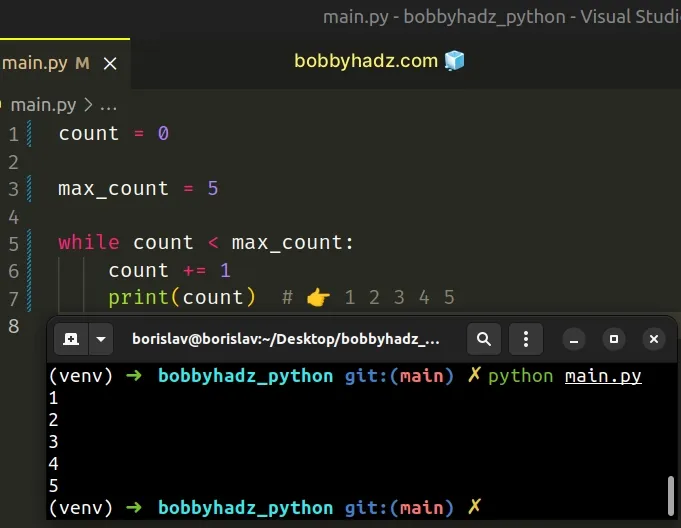
We declared a count variable and set it to 0.
The max_count variable is used in the condition of the while loop.
while loop keeps iterating until the value of count is equal to or greater than the value of max_count.On each iteration, we increment the value of the count variable by 1 to move
towards the case where the condition is no longer met.
# Counting how many times a while loop runs
You can also use this approach to count how many times a while loop runs.
count = 0 my_list = ['bobby', 'hadz', 'com'] while len(my_list) > 0: my_list.pop() count += 1 print(count) # 👉️ 1 2 3 print(count) # 👉️ 3
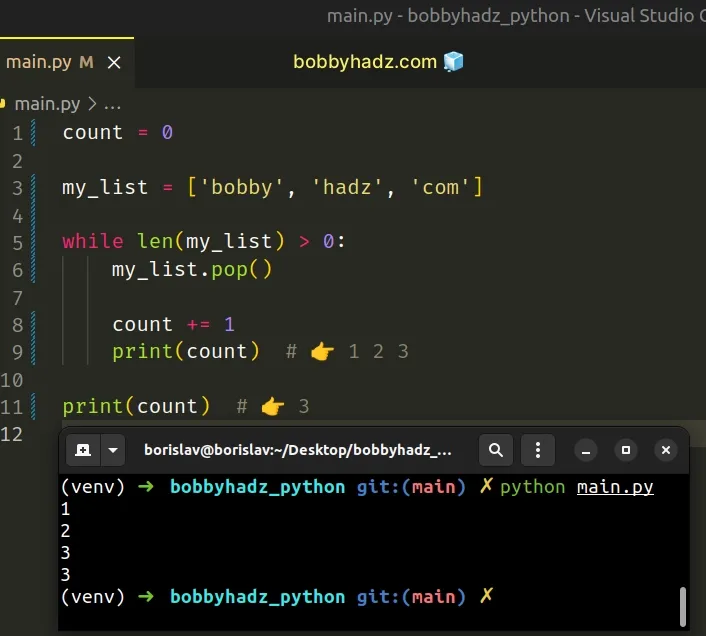
On each iteration of the while loop, we increment the count variable and
remove an item from a list.
The while loop keeps iterating and counting until the list is empty.
The += operator is a shorthand for count = count + 1.
The following code sample achieves the same result using the more verbose syntax.
count = 0 my_list = ['bobby', 'hadz', 'com'] while len(my_list) > 0: my_list.pop() count = count + 1 print(count) # 👉️ 1 2 3 print(count) # 👉️ 3
If you don't have a condition and only need to iterate N times and keep track of
the count, you can also use the range() class.
The range() class is commonly used for looping
a specific number of times in for loops and takes the following arguments:
| Name | Description |
|---|---|
start | An integer representing the start of the range (defaults to 0) |
stop | Go up to, but not including the provided integer |
step | Range will consist of every N numbers from start to stop (defaults to 1) |
If you only pass a single argument to the range() constructor, it is
considered to be the value for the stop parameter.
for n in range(5): print(n) result = list(range(5)) # 👇️ [0, 1, 2, 3, 4] print(result)
start argument is omitted, it defaults to 0 and if the step argument is omitted, it defaults to 1.If values for the start and stop parameters are provided, the start value
is inclusive, whereas the stop value is exclusive.
result = list(range(1, 5)) # 👇️ [1, 2, 3, 4] print(result)
The range() class is more intuitive to use if you know how many times you need
to iterate in advance.
# Additional Resources
You can learn more about the related topics by checking out the following tutorials:

